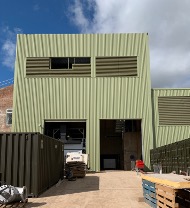Haylers End Energy Recovery Plant
One of the most recent Clinical Waste Incinerators to built in the UK in the last 20 years, Haylers End Energy Recovery Plant will trade under the brand Clinitek and is referred to as their Malvern facility[1]. Andusia are acting as the sole supplier to the plant[2].
| Haylers End Energy Recovery Plant | |
 See HT & Clin → page for a larger UK Wide map. | |
| Waste Licence | SP3507PN |
| Operator | Clinitek |
| Operational Capacity | 8,000tpa |
| Number of Lines | |
| Region | West Midlands |
Annual Report Data
| Year | Total In | Total Clinical | IBA Out | ACP Out | Op Hours
|
|---|---|---|---|---|---|
| 2019 | |||||
| 2018 | |||||
| 2017 | |||||
| 2020 | 0 | 0 | 0 | 0 | 0 |
| 2021 | 0 | 0 | 0 | 0 | 0 |
| 2022 | 0 | 0 | 0 | 0 | 0 |

Summary
One of the most recent Clinical Waste Incinerators to built in the UK in the last 20 years, Haylers End Energy Recovery Plant will trade under the brand Clinitek and is referred to as their Malvern facility[1]. Andusia are acting as the sole supplier to the plant of up to 8,000 tonnes per annum over a 5 year contract[3].
Background
P3P Partners have developed the facility under their subsidiary Waste Energy Power Partners (WEPP) with finance by Equitix. The facility has been built on the derelict Haylers End Incinerator (which has been derelict since 1995) and was reported as in commissioning in January 2021, the original timetable having been delayed from the end of 2020[4][5]. This was the first of two plants developed under the same arrangements, the second being Scotia Business Park and often referred to as their Stoke-on-Trent plant, which has double the design throughput capacity of this facility.
Plant
Commissioning is in an advanced stage. The technology provider is understood to be the same as the Scotia Business Park - supplied by Icinco[1] with 1,000kg/hr capacity and with construction oversight by Cobalt Energy[6]. At 8,000 hrs annual operation the maximum annual throughput would be 8,000 tonnes per annum, although the plated capacity has been reported as 6,400 tonnes in the past.
